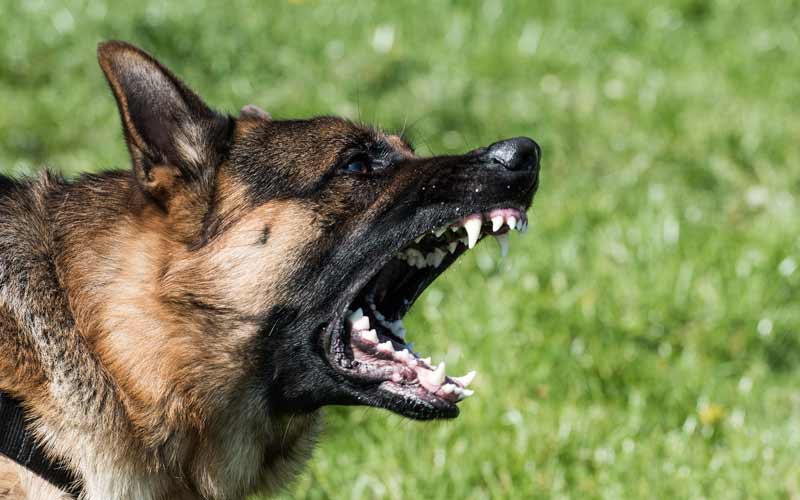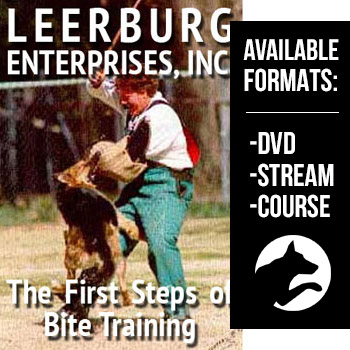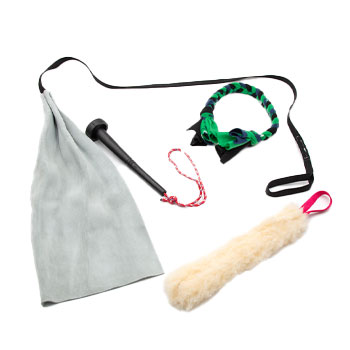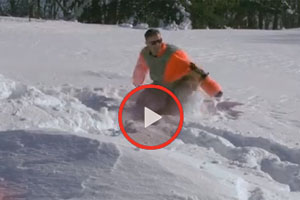Training the Non-Biting Dog to Bark at the Door

I am often asked by new customers (that do not want to do bite work with their dog) how to teach their dog to be more protective. Basically, they want a dog to bark and let strangers know that there is a dog present. When you stop and think about it, that's all that 99.9% of the people that have protection dogs need.
To begin with, I think that people who want to do this bark training still need to understand something about the drives of protection training, even if it's only the basics. So read the article I wrote on the subject after you finish with this article.
Some dogs, because of their genes or temperament, are never going to be able to do any type of protection training. They totally lack defensive drive. The only thing that they can be taught to do is to bark on command. We will discuss this method first. Other dogs have the genetic background to do bitework but the owners do not wish to take the dogs through bite development. We will discuss these dogs after.
For Dogs Who Have No Defensive Drive
There are several ways to teach a dog to bark for a treat (or a favorite toy). The simplest is in your kitchen or bark yard. The most important thing in this training is to be consistent with the choice of words you use for "bark" and to praise with the first bark or noise. I use the German word "GEBLOUT." Not many people know what GEBLOUT means and it sounds better than to say, "SPEAK" or "BARK".
It's also important to sound enthusiastic when trying to get the dog to bark. In other words, make a game out of it. Don't think that because the purpose of this training is to eventually have the dog bark at the door that you must sound serious.
The hardest part of this training is to initially get the dog to understand what you want it to do which is bark on command. It seems that once the light bulb goes off in their head, they enjoy the game (some like it a little too much.) Some dogs are not natural barkers. Especially if you have tried to control unwanted barking.
One of the best ways I have found to get a dog started in the bark exercise is to add frustration with the reward. In other words, the dog up to the kitchen table leg or your fence in the back yard. Make sure you continuously train in this same spot. Tease it with the treat as you back away. Go out of sight, if necessary, as you call out to the dog. The most important part of this exercise is to react instantly to any type of noise from the dog, even a whine. Come running back and praise with "GOOD GEBLOUT, GOOD GEBLOUT." Give the treat and start again. It seems puppies pick up on this quicker than older dogs. The only problem is that once they learn the game, it's hard to shut them up.
Another important issue is to only expect ONE BARK. For a long time in training, it's only necessary to reward one bark. As the dog gains experience and reliability, we will expect two or three barks. But that's way down the road.
Once the dog is consistent in the bark command in the same location on the tie-out, the next training step is to teach the dog to bark in other places. So move the tie-out to different locations around the house and yard. See if the dog will bark on command when you are out playing or walking with him. During these play sessions, stop and give quick direct eye contact and an enthusiastic GEBLOUT command. If he hesitates, show him the treat and repeat the command. The dog only needs to bark one time.
You will be making headway when you can give the command in a play session without the dog knowing that you have the toy or treat ready for a reward.
The game is advanced to the point where the dog is inside the house and the owner steps out the door as he gives the bark command. While outside, he should ring the doorbell or knock on the doors. When the dog barks he comes in and plays. Try and get to the training step where your dog is tied, you step outside without giving the bark command, ring the doorbell or knock on the door, and the dog barks. Whatever happens, always ring or knock before giving the command.
The next step is for a family member to get involved and step outside to knock or ring the bell. The owner stays inside to give the bark commands. If there is a problem at this training step, back the training up to the initial familiar tie-out spot. Have the family member play the game and see if they can get the dog to bark for them. Always remember to lavish the praise on the dog. You will find the more praise, the funner the game and the quicker the dog learns.
Once the dog will play the game with the family member (or friend), then go back to the door. The goal of this training step is to get the dog to realize that if he barks at the door he is going to be rewarded with a treat or a toy and play.

Throughout all of this training, it's important not to overdo the exercise during any one training session. Get the dog to bark 3 or 4 times and quit. Let him do something else for 45 minutes and then try it again 3 or 4 times. If you do it too many times and the dog gets tired or bored with the game, you have created your own problem.
During training, the work should also be done at night. Many dogs with this type of temperament are more nervous about things at night. If the game is played at night (when you will most likely need the dog to bark anyway) it will be used to barking at the door when it's dark out. But the dog must learn that this is not just a "day game."
The last training goal is to get the dog to bark without seeing the person leave the house with the toy. Set this up with a family member to take the toy or treat to the store. When they return, they should ring the bell, the handler gives the bark command, and the dog barks and gets the treat. Again, we are only expecting ONE BARK at the beginning of each new training step. As the dog gains experience, each step will expand it to 3 or 4 barks.
The first time you try this, it may be necessary for the family member to crack the door a bit to let the dog see them and the treat. Remember that each training step is something new for the dog. It may take a little creative thinking to make the old light bulb go off in the dog's head.
For Dogs with the Genes to Do Bite Training
Some dogs can do protection work but the owners don't care to pursue it or don't have the skills to train it. These dogs can be worked slightly differently than what we have talked about above.
Don't assume that just because you have a German Shepherd, Doberman, or Rottie that your dog can be worked in the method I am about to describe. The odds are that if they are American bloodline dogs, they CAN NOT do this defensive training. The working ability has been bred out of the American dogs. I've written about the difference between German and American bloodlines if you are interested in learning more about it.
In this next type of training, we will use the dog's natural suspicion levels to enhance his barking. This usually must take place when the dog's defensive drive starts to develop. That will be dictated by genes and the dog's environment. I have one of my 5-month-old puppies with very sound temperament that will react to the next method, I have also seen many dogs that need to be 24 months of age before they are ready.
This exercise is set up at night when the dogs are more alert. Have a friend hide in the bushes in an area where you will be walking your dog. It doesn't hurt to have the friend wear a ski mask or scarf around his face. (You may want to notify your neighbors before trying this.) This location should be in an area where you will not encounter any other people (if possible).
Approach the friend from the downwind side (make sure the wind is blowing from the friend's location to you so the dog can smell him before you get to him). Set it up so you are walking the dog for several hundred yards before you actually encounter the spot where the person is hiding. As you approach the spot (about 50 to 100 yards out), stop talking and pay close attention to your dog. You want to look for the exact moment the dog smells the person who is hiding. If the dog shows the slightest indication that it smells something out there, you need to act your part. Sound suspicious and say, "WHAT IS THAT?" with a great deal of seriousness in your tone. You can whisper the concern to the dog so that he knows there is something different going on here.
As soon as the friend sees the dog, have them jump out, look at the dog for no more than one second, and then have them run away. As the person is running away, you need to give your dog a great deal of praise. Initially, we don't want the dog to chase the person. That's the end of the exercise. We do this multiple times to continue to increase his suspicion levels.
If the dog does not react, the person in hiding can have a can or milk jug with a couple of rocks in it. At about 10 yards, the handler should stop when he hears the can being rattled. Give the warning to the dog, "WHAT IS THAT?" and wait a few seconds. If there is no growl or bark, the suspect steps out, tosses the can on the ground in front of the dog, and runs away. I always have a prearranged signal with the suspect to come out when I want them to. Many times, the dog will just growl softly. The suspect can't hear it and we want him to react instantly to this growling. Later we will expect the bark.
If the dog is old enough (mature enough) and has the right genetic background, it does not take long for him to realize that by barking at a person in hiding, that person is going to jump and run away from him. At no time during this work does the suspect take steps towards the dog and threaten it. That would be counterproductive to the goals of this type of training.
When the dog is doing a good job of smelling the suspect and barking when the handler alerts him, the training will change a little. The suspect now hides upwind of the dog (the wind is blowing from the back of the dog team) so the dog cannot smell the hidden person until he is actually by the person.
Now when the handler is about 10 yards from the suspect, he will stop and give an alert command. The dog will not smell the person if the setup is correct. The person will step out, stop and stare at the dog and when it barks, he will run away. This teaches the dog to listen to his handler's warning. It teaches him that just because he cannot smell anything, if the handler says there is something there, then there is something to be careful of.
There are a million variations to this exercise. By using good common sense and watching the reaction of the dog, a handler can fine-tune what he wants. You can do things like have a person walking towards you at night on a dark street. Give the alert command at 15 yards. The person stops, stares, kind of puffs himself up a little by squaring off at the dog, and then runs off at the first growl or bark.
You need to be a little careful with this, though. You would not want to do this one too much or the dog will light up on every single person that comes near you at night. That can turn out to be a real pain if you walk your dog a lot in town for exercise.
You can expand the exercise to having the person hide outside your house in your yard. Give the alert command from inside the house and take the dog outside (on leash - this is always done on leash). The suspect runs off and the dog wins another round. This can go on to having someone come to the door after dark and pound loudly on the door. Give the alert, (have the leash handy) and chase the suspect away. By making noises from outside the house away from the door, (i.e. by bedroom windows, etc.) the dog will learn that there are other times that it is appropriate to bark.
Don't start this work at the house though. By going to strange locations, not even where you normally walk, you will raise the dog's alert level and he will be quicker to become suspicious.
If you try this and get the bug for the work, you can take your dog to the next level of training, which is bite development. For this work, you would want to look at my DVD titled The First Steps of Bite Development which is also available to stream online. If you're more interested in bitework, then take a look at my other protection dog training DVDs. But if you have no interest in teaching the dog to bite, you do not need these videos.
The one thing I would strongly recommend is that if you do this work, you need to do an excellent job of obedience training your dog. If you do this alert training and find yourself in the position where someone is bit and sues you, it won't look good if your dog is lacking in basic obedience training. View our DVD on Basic Dog Obedience, also available as a course. Once you've got basic dog obedience down, you can take it to the next level with our Intermediate Dog Obedience DVD or course.










Ask Cindy.